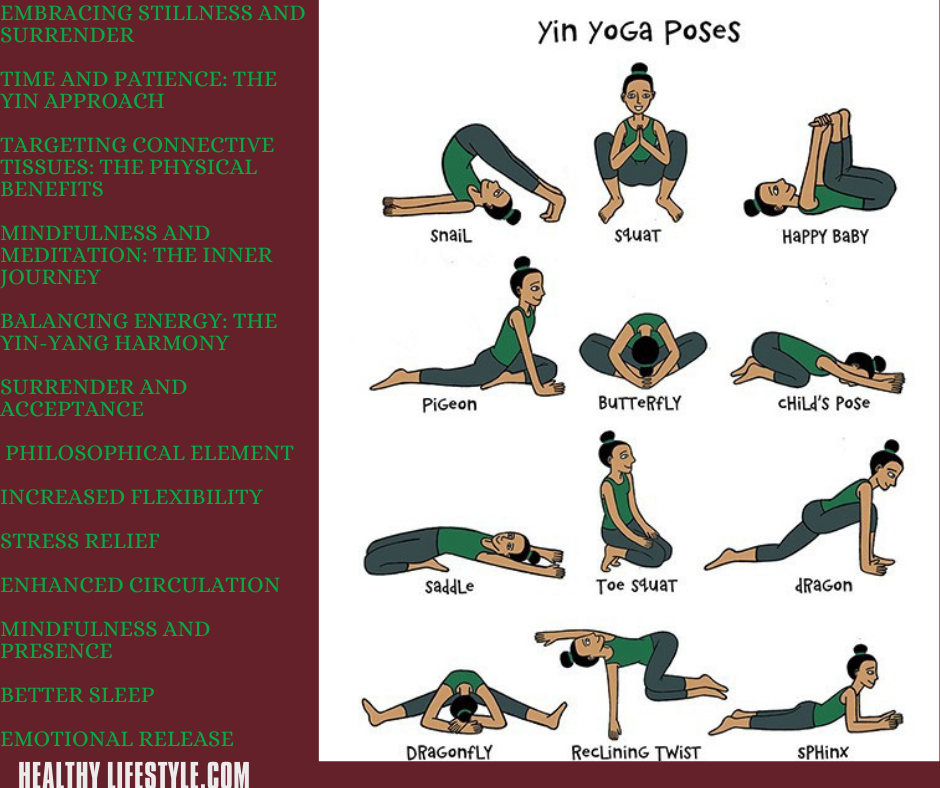Certainly! Here’s an in-depth exploration of the physical benefits of yoga, along with potential side effects, presented in a table format, all within 2000 words:
The 11 Physical Benefits of Yoga: Enhancing Strength, Flexibility, and Well-Being
Yoga, with its roots deeply embedded in ancient Indian tradition, has evolved into a holistic practice that offers a multitude of physical benefits. From improved flexibility to enhanced strength, yoga provides a comprehensive approach to physical well-being. In this article, we will delve into the various physical advantages of practicing yoga, while also addressing potential side effects and precautions.
Table of Contents
- Introduction
- Enhanced Flexibility and Range of Motion
- Strengthening Muscles and Increasing Muscle Tone
- Better Posture and Alignment
- Weight Management and Metabolic Boost
- Cardiovascular Health and Circulation
- Respiratory Efficiency and Lung Capacity
- Digestive Harmony and Gut Health
- Improved Balance and Coordination
- Joint Health and Mobility
- Pain Relief and Management
- Enhanced Athletic Performance
- Side Effects and Precautions
- Conclusion
1. Enhanced Flexibility and Range of Motion by The 11 Physical Benefits of Yoga
Yoga’s emphasis on stretching and holding poses leads to improved flexibility and increased range of motion. Regular practice encourages muscles and joints to move through their full potential, reducing stiffness and promoting suppleness.
Benefits:
- Greater joint mobility: Yoga’s gentle stretches help lubricate joints and maintain their health.
- Injury prevention: Flexible muscles and joints are less prone to strain or injury.
- Eased muscle tension: Stretching relaxes tense muscles, promoting relaxation.
Side Effects and Precautions:
- Overstretching leading to injury: Pushing too hard in poses can result in muscle strains or ligament damage.
- Pre-existing conditions: Individuals with certain medical conditions, such as hypermobility, should approach stretching cautiously.
2. Strengthening Muscles and Increasing Muscle Tone
Yoga involves a variety of weight-bearing poses that engage and challenge muscles throughout the body, contributing to increased strength and muscle tone.
Benefits:
- Full-body workout: Yoga targets major muscle groups, including the core, arms, legs, and back.
- Improved functional strength: Strong muscles support daily activities and prevent imbalances.
- Enhanced metabolism: Muscle gain contributes to a higher resting metabolic rate.
Side Effects and Precautions:
- Overexertion leading to strain: Pushing too hard or holding poses beyond comfort may result in muscle strain.
- Joint stress: Engaging muscles excessively can put strain on joints if proper alignment is not maintained.
3. Better Posture and Alignment
Yoga places significant emphasis on body awareness and alignment. Practicing proper alignment during poses translates to improved posture and spinal health in daily life.
Benefits:
- Spinal health: Yoga promotes a strong and aligned spine, reducing the risk of back pain and discomfort.
- Awareness of body mechanics: Mindful practice encourages conscious movement and posture correction.
- Enhanced body balance: Improved alignment contributes to better overall physical stability.
Side Effects and Precautions:
- Incorrect alignment leading to injury: Improper posture during poses can strain muscles and lead to long-term issues.
- Overcorrection: Overemphasis on alignment may lead to rigidity and discomfort.
4. Weight Management and Metabolic Boost
Certain styles of yoga, such as Vinyasa and Power Yoga, offer a more vigorous practice that elevates heart rate and burns calories, supporting weight management efforts.
Benefits:
- Caloric expenditure: Dynamic yoga styles contribute to increased energy expenditure.
- Muscle activation: Challenging poses engage muscles, aiding in calorie burning and fat loss.
- Improved insulin sensitivity: Yoga’s stress-reducing effects may help regulate appetite and improve metabolic health.
Side Effects and Precautions:
- Overexertion and strain: Vigorous practices may lead to exhaustion or muscle overuse if not approached mindfully.
- Individual variations: Caloric burn varies based on factors such as body weight, intensity, and duration of practice.
5. Cardiovascular Health and Circulation
Certain yoga styles, especially those with dynamic sequences, provide cardiovascular benefits by increasing heart rate and improving blood circulation.
Benefits:
- Heart health: Elevated heart rate during practice improves cardiovascular fitness and reduces the risk of heart disease.
- Blood flow enhancement: Yoga’s inversions and poses promote blood circulation throughout the body.
- Stress reduction: Yoga’s relaxation techniques contribute to lower blood pressure and overall heart health.
Side Effects and Precautions:
- Excessive strain on the heart: Vigorous practices may be unsuitable for individuals with heart conditions.
- Monitoring heart rate: Individuals with cardiovascular issues should consult a healthcare professional before engaging in intense yoga practices.
6. Respiratory Efficiency and Lung Capacity
Pranayama, or breath control, is a fundamental aspect of yoga practice. By focusing on controlled breathing, practitioners enhance respiratory efficiency and lung capacity.
Benefits:
- Increased oxygen intake: Deep breathing techniques improve lung capacity and oxygenation of the blood.
- Lung health: Pranayama practices strengthen respiratory muscles, supporting lung function.
- Stress reduction: Controlled breathing induces relaxation and decreases stress hormones.
Side Effects and Precautions:
- Hyperventilation: Improper or excessive breathing techniques can lead to dizziness or light-headedness.
- Pre-existing respiratory conditions: Individuals with respiratory issues should approach breathwork cautiously and seek guidance.
7. Digestive Harmony and Gut Health
Yoga includes poses that stimulate and massage the digestive organs, promoting better digestion and gut health.
Benefits:
- Enhanced digestion: Twisting poses and gentle compressions aid in the movement of food through the digestive tract.
- Detoxification: Certain poses stimulate the liver and kidneys, supporting the body’s natural detoxification processes.
- Reduced bloating: Yoga’s emphasis on relaxation and circulation can alleviate bloating and discomfort.
Side Effects and Precautions:
- Overeating before practice: Practicing yoga immediately after a heavy meal can lead to discomfort.
- Pre-existing gastrointestinal conditions: Individuals with digestive issues should avoid intense twists and consult a healthcare professional.
8. Improved Balance and Coordination
Many yoga poses require balance and coordination, which over time, can enhance proprioception (awareness of body position) and overall physical stability.
Benefits:
- Fall prevention: Improved balance reduces the risk of falls, especially in older adults.
- Functional mobility: Enhanced coordination translates to smoother and more efficient movement in daily activities.
- Core strength: Balancing poses engage core muscles, contributing to better stability.
Side Effects and Precautions:
- Risk of falls: Balance poses should be approached cautiously, especially by individuals with balance issues.
- Overexertion: Attempting advanced balancing poses without proper progression can lead to strain or injury.
9. Joint Health and Mobility
Yoga’s gentle stretches and fluid movements promote joint health by increasing mobility and preventing stiffness.
Benefits:
- Joint lubrication: Yoga’s range of motion exercises help maintain healthy joint fluidity.
- Arthritis management: Gentle yoga can alleviate joint pain and improve function in individuals with arthritis.
- Injury prevention: Flexible joints are less likely to experience strains or other injuries.
Side Effects and Precautions:
- Overstretching: Extreme joint movement without proper alignment can lead to joint instability and discomfort.
- Pre-existing joint conditions: Individuals with joint-related issues should approach yoga mindfully and seek guidance.
10. Pain Relief and Management
Yoga’s mindful movement and relaxation techniques can contribute to pain relief and management in various areas of the body.
Benefits:
- Back pain relief: Certain poses can alleviate back pain by promoting proper alignment and relieving muscle tension.
- Headache reduction: Relaxation techniques and stress reduction can help alleviate tension headaches.
- Chronic pain management: Yoga’s mind-body connection supports coping mechanisms for chronic pain.
Side Effects and Precautions:
- Incorrect poses aggravating pain: Poor alignment during poses may worsen existing pain conditions.
- Overexertion: Pushing through pain may exacerbate discomfort. Gentle and gradual practice is advised.
11. Enhanced Athletic Performance
Yoga can complement athletic training by improving flexibility, strength, and mental focus, contributing to enhanced overall performance.
Benefits:
- Improved flexibility: Increased range of motion translates to better athletic movement and reduced injury risk.
- Core strength: Yoga’s emphasis on core engagement supports better stability and functional movement.
- Mental resilience: Yoga enhances mental focus and stress management, beneficial for athletes.
Side Effects and Precautions:
- Overtraining: Combining intense yoga practice with rigorous athletic training may lead to exhaustion or overuse injuries.
- Individual variations: The impact of yoga on athletic performance varies based on the specific sport and individual needs.
12. Side Effects and Precautions
While yoga offers a wide range of physical benefits, it’s important to practice mindfully and be aware of potential side effects.
Side Effects:
- Overexertion: Pushing too hard or attempting advanced poses without proper guidance can lead to strain or injury.
- Incorrect alignment: Poor posture during poses may result in muscle strain, joint discomfort, or long-term issues.
- Pre-existing conditions: Individuals with certain medical conditions should consult a healthcare professional before beginning a new yoga practice.
Precautions:
- Practice under guidance: Seek instruction from qualified yoga instructors, especially if you’re new to yoga.
- Listen to your body: Pay attention to your body’s signals and avoid pushing through pain or discomfort.
- Gradual progression: Start with beginner-friendly poses and gradually advance to more challenging ones.
- Medical consultation: If you have pre-existing medical conditions or injuries, consult a healthcare professional before practicing yoga.
Conclusion
Yoga’s physical benefits encompass a wide spectrum, from increased flexibility and muscle strength to improved cardiovascular health and enhanced joint mobility. By practicing yoga mindfully, under qualified guidance, individuals can experience a range of positive effects on their physical well-being. However, it’s essential to approach yoga with caution, respecting individual limitations and seeking professional advice if necessary. As you embark on your yoga journey, you’ll find that the holistic benefits extend far beyond the physical realm, enriching your overall quality of life.
Frequently Asked Questions (FAQ) on The Physical Benefits of Yoga
- Is yoga suitable for beginners, especially those who are not very flexible?
- Absolutely! Yoga is accessible to individuals of all fitness levels and flexibility. Many classes offer modifications to accommodate beginners, allowing you to progress at your own pace.
- Can yoga help with weight loss?
- While certain dynamic forms of yoga can contribute to calorie burning and metabolic boost, yoga’s main focus is on overall well-being. Combining yoga with a balanced diet and regular exercise can aid in weight management.
- Is yoga a good form of exercise for building muscle?
- Yes, yoga can enhance muscle strength and tone through weight-bearing poses. While it may not lead to bodybuilder-level muscle gain, it can certainly contribute to improved functional strength.
- Will yoga improve my posture?
- Yes, yoga emphasizes body alignment and awareness, which can lead to better posture. Engaging core muscles and practicing poses that promote spinal health contribute to improved overall alignment.
- Can yoga help with back pain?
- Yoga’s focus on spinal health and muscle flexibility can be beneficial for alleviating back pain. However, it’s important to practice with proper alignment and consult a healthcare professional if pain persists.
- Is yoga a cardiovascular workout?
- Certain yoga styles, like Vinyasa and Power Yoga, elevate heart rate and offer a cardiovascular workout. However, traditional yoga’s main focus is not solely on cardiovascular fitness.
- Can yoga improve digestion and help with bloating?
- Yes, certain yoga poses stimulate digestion and can alleviate bloating. Twisting poses, gentle compressions, and deep breathing techniques support digestive health.
- Will yoga make me more flexible?
- Absolutely. Consistent yoga practice involves stretching and holding poses, gradually increasing flexibility and range of motion in muscles and joints.
- Is yoga recommended for individuals with joint issues like arthritis?
- Yes, gentle and modified yoga can be beneficial for individuals with arthritis. It can help maintain joint mobility, reduce stiffness, and alleviate discomfort. However, it’s important to consult a healthcare professional before starting a practice.
- Can yoga help with headaches?
- Yes, yoga’s relaxation techniques and stress reduction practices can alleviate tension headaches and promote overall well-being.
- Is there a risk of injury with yoga?
- Like any physical activity, there is a risk of injury if poses are performed incorrectly or pushed too far. Practicing yoga mindfully, under qualified guidance, reduces this risk significantly.
- Can I practice yoga if I have a pre-existing medical condition?
- It depends on the condition. Some medical conditions may benefit from yoga, while others might require modifications or caution. It’s important to consult a healthcare professional before starting a new practice.
- How often should I practice yoga to experience its physical benefits?
- Consistency is key. Aim for at least 2-3 sessions per week to notice improvements in flexibility, strength, and other physical benefits.
- Can I do yoga during pregnancy?
- Prenatal yoga, specifically designed for pregnant individuals, can be safe and beneficial. It’s important to attend classes led by instructors trained in prenatal yoga.
- Are there age restrictions for practicing yoga?
- Yoga is suitable for people of all ages. There are classes tailored for children, seniors, and every age group in between.
healthylifestyel.com/7-types-of-yoga-and-their-focus/











